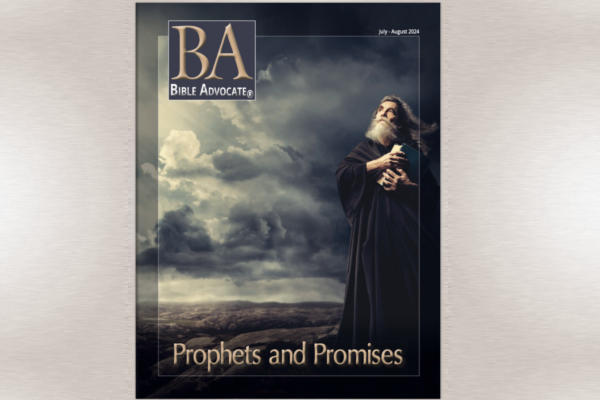In exploring the ministry of reconciliation this year, we will spotlight six chapters from the Bible to aid us in understanding it and all its implications for life in the church.
But before we jump into our first selection, here’s a fascinating piece of trivia. Have you ever wondered how the Bible got the indispensable divisions of what we call chapters? They aren’t in the original languages. It so happens that Cardinal Stephen Langton, working from the Latin Vulgate in 1205, created the divisions we take for granted and find so useful today. (Wouldn’t it be something if our associate editor, Sherri Langton, is a descendant of his?)
The message
Do you have a favorite chapter? I have several, and Ephesians 2 is definitely among them. If your Bible is handy, read it in conjunction with these reflections on reconciliation. The word reconcile appears only once in this chapter, but every verse here relates to its message and meaning: “That He might reconcile them both to God in one body through the cross, thereby putting to death the enmity” (v. 16).
Reconciliation is about restoring relationships — how the broken are healed, how the alienated find family, how enemies become friends. Ephesians 2 tells this story in two parts, with Christ and our togetherness in Him at the center of both:
- Saved in Christ (vv. 1-10)
- United in Christ (vv. 11-22)
Peace with God
The first half of Ephesians 2 tells the cosmic story of our relationship with God. It’s a before-and-after tale. Once we were dead in trespasses and sins. Once we walked according to the course of this world and the Prince of Evil. Once we were children of disobedience and wrath (vv. 1-3). Our need for reconciliation was dire. Captive to our fleshly nature, we were enemies of God — as far from Him as life is from death.
But God, in His rich mercy, great love, and exceeding kindness, entered into the dark chasm of alienation to bridge the gulf in Christ: “by grace you have been saved” (vv. 4, 5). Our before-and-after hinges on Christ. The once is now reversed. Now we are made alive with Christ. Now we are raised up with Christ. Now we are seated with Christ. This is God’s saving peace, and it is ours together in Christ (vv. 4-7).
None of this is of ourselves; it is an unaccountable gift of grace received in empty-handed faith (v. 8). The spirit that worked in us to disobey (v. 2) has been defeated, our own meager boastful works dismissed (v. 9). This happened so that God’s workmanship might be revealed to make new creations of us, for good works, in Christ (v. 10). That old walk in death has been exchanged for a new walk in life (vv. 2, 10).
Peace with others
Our cosmic reconciliation from death to life in Christ, in the first half of Ephesians 2, prepares the way for the second half of the chapter. With our relationship to God restored in Christ, our relationships with one another must now be reassessed. Paul does not present this salvation and reconciliation in individualistic terms, but as what God in Christ has done for us, together, collectively. And so God’s cosmic tale takes a turn to the local and the reality of animosity between Gentile and Jew.
Linking to the before way in the flesh (v. 1), in verse 11 Paul recalls how these Christian Gentiles and Jews were once defined and divided by their uncircumcision in the flesh and circumcision in the flesh made by human hands. Once again, flesh separates. In addition, the Gentiles were once without Christ and God, once aliens from Israel, strangers to her covenants of promise, once without hope (v. 12). The need for reconciliation was desperate, captive to fleshly identities. Both enemies of each other, this reality was as far from unity as death is from life.
“But now in Christ Jesus you who once were far off have been brought near by the blood of Christ” (v. 13). Here we see a biblical synonym for reconciliation: peace. Jesus is our peace. He made peace. He preached peace. He has broken, abolished, and put to death on the cross all obstacles of flesh and ordinances of law that once separated and caused enmity. New creation continues. In the peace of Christ, God has created one new man, one new body, with access to the Father by the Spirit (vv. 14-17). This is God’s uniting peace, and it is ours together in Christ.
The challenge
This applies not only to Jew and Gentile but to every sort of division humans can imagine.
The beauty of Ephesians 2 is how we learn that in Christ, God has brought near all who are far off — near both to Him and to each other. In this new relationship strangers and foreigners become fellow citizens and members of the household of God. Now we are looking forward as we are being built up together, fitted together, growing together into a holy temple in the Lord, a dwelling place of God by the Holy Spirit (vv. 19-21). What a ministry to belong to, what a responsibility to share together.
Pointing our spotlight on Ephesians 2 puts the spotlight squarely on us. Are we, the Church of God, walking as a new creation in the peace of Christ together? Pray we can embody in our unified life this message of reconciliation — saved and unified — in the cross of Christ. The Bible may be divided into many chapters, but Christ is its singular message.








